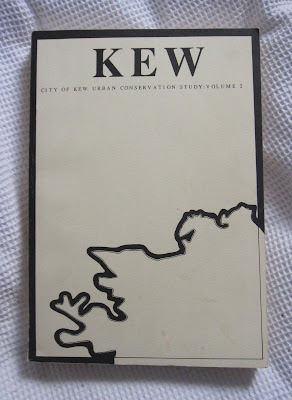
We have lots of fascinating books covering the history of the area in the City of Boroondara Library Service's collections. And sometimes the titles and covers are not very good give-aways of their usefulness.
Take the cover of Kew: City of Kew Urban Conservation Study which was published by the former City of Kew in 1988. Does that give you any idea of the gems inside it? It looks like a standard report with a meandering Yarra going through it. Volume 1 is just that and covers planning controls, methodology, the Burra Charter, etc.
But volume two whose cover is illustrated above is an incredibly useful tool to family and local historians and to library staff. It has a useful 31 page summary of the history of Kew from early days to the late 1970s. Whilst the focus is on planning and development and the built form, it is a very useful tool if someone is looking for a quick context to a property or just wants a quick glimpse into Kew's past. This section also includes a range of maps and subdivision plans from different eras that give a good sense of how the city came to be as it was in 1988 and provides the context for how it has evolved further until today.
The second part of volume two had detailed histories of Grade A properties and limited information on Grade B properties. This includes houses of various eras from the early to mid Victorian up until post World War II as well as churches, memorials and institutions and provides a great tool. The 1988 illustrations are an historical resource in their own right.
The next section covers open spaces and examines formal parklands such as Alexandra Gardens, something defined as Remnants of Former Users which includes the former Outer Circle Railway, Yarra Boulevard, and Flood prone areas such as the two golf clubs and Hay's Paddock. Again each section provides a short history of each site as well as current conditions.
The final section is entitled Building Conservation Guidelines and includes all sort of useful surveys of elements of buildings. So if you want a bit of information about chimneys in the early 20th century, this is a good tool.



No comments:
Post a Comment